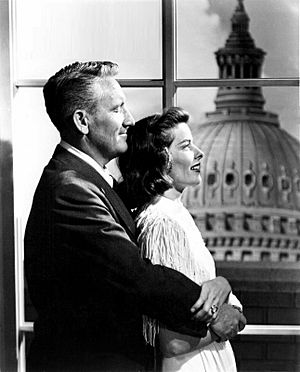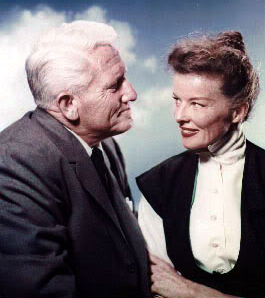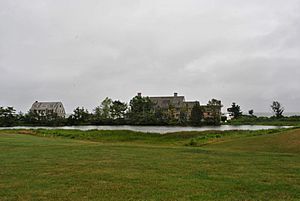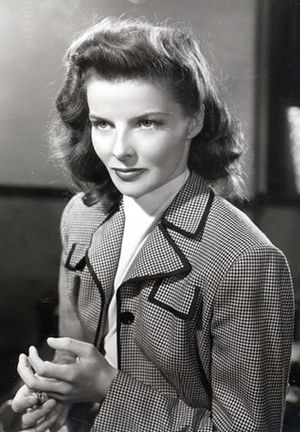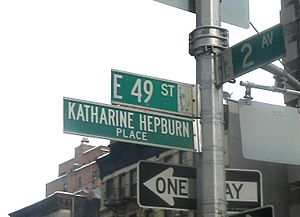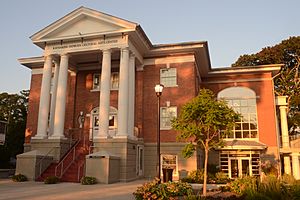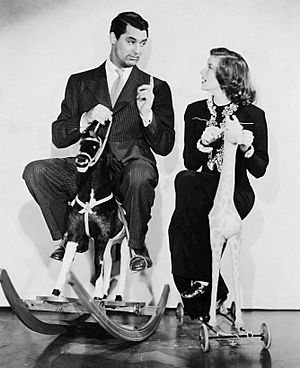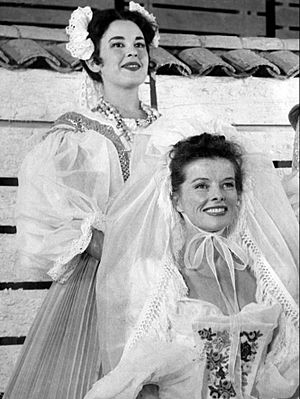Katharine Hepburn facts for kids
Quick facts for kids
Katharine Hepburn
|
|
|---|---|
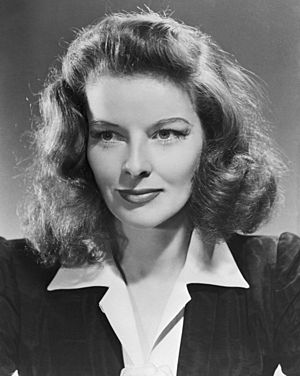
Studio publicity photograph, c. 1941
|
|
| Born |
Katharine Houghton Hepburn
May 12, 1907 Hartford, Connecticut, U.S.
|
| Died | June 29, 2003 (aged 96) Fenwick, Connecticut, U.S.
|
| Resting place | Cedar Hill Cemetery, Hartford |
| Alma mater | Bryn Mawr College |
| Occupation | Actress |
| Years active | 1928–1994 |
| Spouse(s) |
Ludlow Ogden Smith
(m. 1928; div. 1934) |
| Partner(s) | Spencer Tracy (1941; d. 1967) |
| Parent(s) | Thomas Norval Hepburn Katharine Martha Houghton |
Katharine Houghton Hepburn (born May 12, 1907 – died June 29, 2003) was a famous American actress. She was known for being very independent and having a strong personality. Hepburn was a top actress in Hollywood for over 60 years.
She acted in many types of movies, from funny comedies to serious dramas. She won a record four Academy Awards for Best Actress. In 1999, the American Film Institute named Hepburn the greatest female star of Classic Hollywood Cinema.
Katharine grew up in Connecticut with wealthy parents who believed in social progress. She started acting while studying at Bryn Mawr College. After performing in plays for four years, her great reviews on Broadway caught Hollywood's attention.
Her first years in movies were very successful. She even won an Academy Award for her third film, Morning Glory (1933). However, she then had several movies that did not do well. This led to her being called "box office poison" in 1938.
Hepburn planned her own comeback. She bought out her contract with RKO Radio Pictures. She also got the movie rights to The Philadelphia Story. She sold these rights only if she could be the star. In the 1940s, she signed with Metro-Goldwyn-Mayer. Her career there focused on working with Spencer Tracy. They acted together for 25 years and made nine movies.
Hepburn kept challenging herself later in life. She often appeared in Shakespearean plays. She also took on many different literary roles. She became well-known for playing middle-aged single women, like in The African Queen (1951). People really liked this type of character.
She won three more Oscars for her work in Guess Who's Coming to Dinner (1967), The Lion in Winter (1968), and On Golden Pond (1981). In the 1970s, she started acting in television films. These became the main focus of her career later in life. She stayed active even when she was old. Her last movie was in 1994 when she was 87. After being less active and having health problems, Hepburn passed away in 2003 at age 96.
Hepburn famously avoided Hollywood's public attention. She also refused to follow what society expected of women. She was outspoken, confident, athletic, and wore trousers before it was common for women. She was married briefly when she was young. After that, she lived on her own. She had a 26-year relationship with her co-star Spencer Tracy. This relationship was kept private from the public. With her unique lifestyle and the strong characters she played, Hepburn became a symbol of the "modern woman" in the 20th century. She is remembered as a very important cultural figure.
Contents
Early Life and Education
Katharine Hepburn was born in Hartford, Connecticut. She was the second of six children. Her parents were Thomas Norval Hepburn (1879–1962) and Katharine Martha Houghton (1878–1951). Her mother was a strong supporter of women's rights. Both parents worked for social change in the U.S. As a child, Hepburn joined her mother in protests for women's right to vote. The Hepburn children were taught to speak freely. They were encouraged to think and discuss any topic. She stayed close to her family throughout her life.
The young Katharine was a tomboy and cut her hair short. Her father, Thomas Hepburn, wanted his children to use their minds and bodies fully. He taught them to swim, run, dive, ride horses, wrestle, and play golf and tennis. Golf became a big passion for Hepburn. She took lessons daily and became very skilled. She even reached the semi-final of the Connecticut Young Women's Golf Championship. She loved swimming in Long Island Sound. Hepburn loved movies from a young age. She went to see one every Saturday night. She would put on plays for her neighbors with friends and siblings. They charged 50 cents a ticket to raise money for the Navajo people.

In 1924, Hepburn was accepted into Bryn Mawr College. It was her first time in school for several years. She felt shy and uncomfortable with her classmates. She found the schoolwork difficult. Hepburn was drawn to acting. However, roles in college plays depended on good grades. Once her grades improved, she started performing regularly. In her final year, she played the main role in The Woman in the Moon. The positive feedback she received made her sure she wanted to be an actress. She graduated in June 1928 with a degree in history and philosophy.
Hepburn left college determined to become an actress. The day after graduating, she went to Baltimore. She met Edwin H. Knopf, who ran a successful theater company. Knopf was impressed by her eagerness. He cast Hepburn in his play, The Czarina. She received good reviews for her small part. The Printed Word said her performance was "arresting."
Private Life and Interests
Hepburn was known for being very private. She would not give interviews or talk to fans for most of her career. She stayed away from the celebrity lifestyle. She found the social scene boring and fake. She wore casual clothes, which was very unusual for a star in that glamorous time. She rarely appeared in public, even avoiding restaurants. Once, she even took a camera from a photographer who took her picture without asking.
Even though she loved her privacy, she enjoyed her fame. She later admitted she would not have liked the press to ignore her completely. Her protective attitude about her private life changed as she got older. Starting with a two-hour interview on The Dick Cavett Show in 1973, Hepburn became more open with the public.
The actress lived a very active life. She reportedly swam and played tennis every morning. In her eighties, she was still playing tennis regularly.
Hepburn liked to go barefoot. For her first acting role in the play "The Woman in the Moon," she insisted her character Pandora should not wear shoes. Off-screen, she usually wore slacks and sandals. She even wore them for formal events like TV interviews. The American Humanist Association gave her the Humanist Arts Award in 1985.
Final Years and Passing
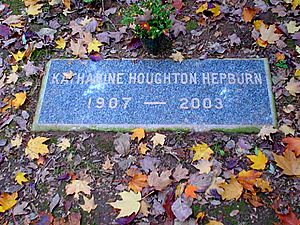
In her eighties, Hepburn said, "I have no fear of death. Must be wonderful, like a long sleep." Her health began to get worse after her last movie. She was hospitalized in March 1993 for exhaustion. In the winter of 1996, she was hospitalized with pneumonia. By 1997, she had become very weak. She was speaking and eating very little.
In May 2003, a growth was found in Hepburn's neck. It was decided not to do surgery. She passed away from a heart attack on June 29, 2003. This was a month after her 96th birthday. She died at the Hepburn family home in Fenwick, Connecticut. She was buried in Cedar Hill Cemetery in Hartford. Hepburn asked for no memorial service.
After Hepburn's death, film historian Jeanine Basinger said, "What she brought us was a new kind of heroine—modern and independent. She was beautiful, but she did not rely on that." Mary McNamara, a journalist for the Los Angeles Times, wrote, "More than a movie star, Katharine Hepburn was the patron saint of the independent American female."
Hepburn's death received a lot of public attention. Many tributes were shown on television. Newspapers and magazines dedicated issues to the actress. American president George W. Bush said Hepburn "will be remembered as one of the nation's artistic treasures." To honor her many theater performances, the lights of Broadway were dimmed on the evening of July 1, 2003. In 2004, as Hepburn wished, her belongings were sold at auction by Sotheby's in New York City. The event raised $5.8 million, which Hepburn left to her family.
Lasting Impact and Recognition
Katharine Hepburn is seen as an important and influential cultural figure. Ros Horton and Sally Simmons included her in their book Women Who Changed The World. This book honors 50 women who helped shape world history and culture. She is also named in Encyclopædia Britannica's list of "300 Women Who Changed the World." She is in Ladies Home Journal's book 100 Most Important Women of the 20th century. She is also in Variety magazine's "100 Icons of the Century." She is number 84 on VH1's list of the "200 Greatest Pop Culture Icons of All Time." In 1999, the American Film Institute named Hepburn the "greatest American screen legend" among females.
About Hepburn's film legacy, one of her biographers, Sheridan Morley, said she "broke the mold" for women in Hollywood. She brought a new type of strong-willed female character to the screen.
Off screen, Hepburn's lifestyle was ahead of her time. She came to symbolize the "modern woman." She played a part in changing ideas about gender. Horton and Simmons write, "Confident, intelligent and witty, four-time Oscar winner Katharine Hepburn defied convention throughout her professional and personal life ... Hepburn provided an image of an assertive woman whom [females] could watch and learn from."
Hepburn's impact also extends to fashion. She was a pioneer in wearing trousers at a time when it was a very bold move for a woman. She helped make trousers acceptable for women. Fans began to copy her clothing style. In 1986, she received a lifetime achievement award from the Council of Fashion Designers of America. This was in recognition of her influence on women's fashion.
Memorials and Tributes
Katharine Hepburn has been honored with several memorials. The Turtle Bay community in Manhattan, New York City, dedicated a garden in her name in 1997. She lived there for over 60 years. After Hepburn's death in 2003, the intersection of East 49th Street and 2nd Avenue was renamed "Katharine Hepburn Place." Three years later, Bryn Mawr College, Hepburn's old school, opened the Katharine Houghton Hepburn Center. It is dedicated to both the actress and her mother. It encourages women to work on important issues affecting their gender.
The Katharine Hepburn Cultural Arts Center opened in 2009 in Old Saybrook, Connecticut. This is where the Hepburn family beach home was, which she loved and later owned. The building has a performance space and a Katharine Hepburn museum.
The Academy of Motion Picture Arts and Sciences library and the New York Public Library have collections of Hepburn's personal papers. Some items from the New York collection were shown in a five-month exhibition in 2009. It was called Katharine Hepburn: In Her Own Files and showed her theater career. Other exhibitions have also been held to highlight Hepburn's career.
Hepburn has also been honored with her own postal stamp. This was part of the "Legends of Hollywood" stamp series.
Film and Theater Work
During her 66-year career, Katharine Hepburn acted in 44 feature films, 8 television movies, and 33 plays. Her movie career included many types of films. These were funny comedies, historical dramas, and movies based on famous American plays. She performed on stage in every decade from the 1920s to the 1980s. She acted in plays by Shakespeare and Shaw. She also performed in a Broadway musical.
Some of her films:
- Morning Glory (1933)
- Little Women (1933)
- Alice Adams (1935)
- Stage Door (1937)
- Bringing Up Baby (1938)
- Holiday (1938)
- The Philadelphia Story (1940)
- Woman of the Year (1942)
- Adam's Rib (1949)
- The African Queen (1951)
- Pat and Mike (1952)
- Summertime (1955)
- Desk Set (1957)
- Suddenly, Last Summer (1959)
- Long Day's Journey into Night (1962)
- Guess Who's Coming to Dinner (1967)
- The Lion in Winter (1968)
- Love Among the Ruins (1975)
- Rooster Cogburn (1975)
- On Golden Pond (1981)
Images for kids
-
Hepburn made four films with Cary Grant. They are seen here in Bringing Up Baby (1938), which flopped on release, but has since become renowned as a classic screwball comedy.
-
Trailer for Woman of the Year (1942)
-
The majority of films Hepburn did in this period were with Spencer Tracy. She later said the partnership did much to advance her career, as he was the more popular star at the time. Seen here in Adam's Rib (1949).
-
Hepburn often worked abroad in the 1950s, beginning with The African Queen with co-star Humphrey Bogart.
-
In David Lean's romantic drama Summertime (1955). Jane Hudson is one of the popular "spinster" roles Hepburn played in the 1950s.
-
From the trailer for Suddenly, Last Summer (1959), based on the play by Tennessee Williams
-
In Guess Who's Coming to Dinner (1967), which won Hepburn her second of four Academy Awards
-
In the western Rooster Cogburn (1975), which Hepburn costarred with John Wayne
See also
 In Spanish: Katharine Hepburn para niños
In Spanish: Katharine Hepburn para niños


